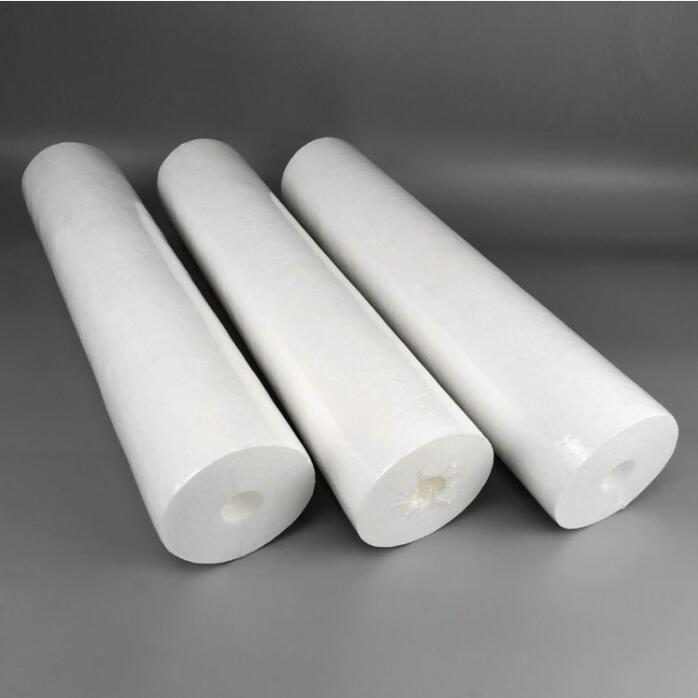What is PP melt-blown filter element

PP melt blown filter element is made of non-toxic and odorless polypropylene particles through heating, melting, spinning, stretching and receiving. If the raw material is mainly polypropylene. It can be called PP melt-blown filter element. This is true not only in the field of water purification, but also in the field of air purification. It also has excellent chemical compatibility and is suitable for the filtration of strong acids, strong alkalis and organic solvents. It has strong ability to absorb pollution, long service life and low cost.
Operating parameters
Filtering precision: 1µ m,3µ m,5µ m,10µ m,20µ m,30 µ m,60µm.
Sterilization: withstand 126 ° C, online steam sterilization for 30 minutes.
Endotoxin: the content of endotoxin in the water extract of the filter column after lAL test is less than 0.5EU/ml
Performance Characteristics
(1)Filtration efficiency and filtration precision, uniform pore size density of filter element, and filtration efficiency above 99%.
(2)Low filtration resistance, large filtration flow, large pollution capacity and long service life. Fiber diameter and gap can be adjusted during production. The inner layer of the filter element is smaller and the outer layer is larger, which increases the flow and pollution capacity. The filter element is not easy to block, and the service life is extended.
(3)High cleanliness, no pollution, acid and alkali resistance, organic solvent resistance, corrosion resistance.
(4)High strength, the filter element will not deform when the water pressure difference at the inlet and outlet of the filter exceeds 0.4Mpa, and the filtering efficiency will not decrease when the temperature exceeds 90 ℃.
(5)After treatment and modification of polypropylene, the product has extremely high hydrophilicity and can absorb 10 times the weight of water, so it can be used for oil-water separation.
Manufacturing Process
PP melt blown filter element has a structure of coarse outer fiber, fine inner fiber, loose outer layer and tight inner layer. The unique gradient deep filtration forms a three-dimensional slag filtration effect, which is characterized by high porosity, high retention rate, large pollutant capacity, high flow rate and low pressure.
Melt-blowing process is a polymer extrusion nonwoven process, which originated in the early 1950s. In order to collect radioactive particles produced by nuclear tests, the United States Navy Laboratory began to develop filter materials with ultra-fine filtration effect, and published its research results in 1954. China's melt-blowing technology originated in the late 1950s and early 1960s, and the equipment studied is intermittent. By the late 1960s and early 1970s, the number of intermittent melt-blowing equipment in China had reached more than 200. About 92-94 continuous production lines have been introduced from the United States and Germany. So far, it is estimated that there are still more than 300 intermittent melt-blowing equipment in operation nationwide.
In theory, all thermoplastic (high-temperature melting, low-temperature curing) polymer chips can be used in the manufacturing process of meltblown filter elements. Polypropylene is one of the most widely used chip materials in melt-blown process. In addition, polymer chips commonly used in melt blow molding process include polyester, polyamide, polyethylene, polytetrafluoroethylene, polystyrene, PBT, EMA, EVA, etc. The degree of polymerization of olefin polymer raw materials (such as polypropylene) is high, so the heating temperature is 100 ℃ higher than its melting point. When the heating temperature is slightly higher than its melting point, the polyester can be melted and blown. Olefin feedstocks usually do not need to be dried.
The structural feature of PP melt blown filter element is that the fiber fineness is relatively small, usually less than 10 microns, and most of the fiber fineness is between 1 and 4 microns.
Application Area
Air purification industry:air filtration.
Pharmaceutical industry: prefiltration of various injections, liquid medicine and injection bottle washing water, and prefiltration of large infusion, various antibiotics and traditional Chinese medicine injections.
Food industry: filtration of alcohol, beverages and drinking water.
Electronic industry: pre-filtration of pure water and ultra-pure water.
Petroleum and chemical industry: filtration of various organic solvents, acids and lyes, and filtration of oilfield water injection.





















